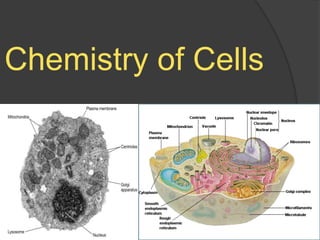
Cells
- 2. Carbon Compounds Most matter in our body that is not made of water is made of organic compounds. Organic compounds contain carbon atoms that are covalently bonded to other elements; typically hydrogen, oxygen, and other carbon atoms. Remember, Covalent bonds form when two or more atoms share electronsto form a molecule. Covalent bond
- 3. Carbon Compounds Four principal classes of organic compounds are found in living things. Carbohydrates Lipids Proteins Nucleic acids proteins carbohydrates Lipids Nucleic acids
- 4. Carbohydrates Carbohydrates are organic compounds made of carbon, hydrogen, and oxygen atoms. Carbohydrates are a key source of energy and are found in most foods; especially fruits, vegetables, and grains. Foods containing carbohydrates
- 5. Carbohydrates The building blocks of carbohydrates are single sugars called monosaccharides. Single sugars such as glucose and fructose are a major source of energy in cells. glucose
- 6. Carbohydrates Disaccharides are double sugars formed when two monosaccharides are joined. Sucrose, a common table sugar, is formed when glucose and fructose are joined.
- 7. Carbohydrates Polysaccharides, such as starch, are chains of three or more monosaccharides. A polysaccharides is an example of a macromolecule, a large molecule made of many smaller molecules.
- 8. Carbohydrates In organisms, some polysaccharides function as storehouses of the energy contained in sugars Two polysaccharides that store energy in this way are starch, which is made of plants, and glycogen, which is made from animals. Both starch and glycogen are made of hundreds of linked glucose molecules. starch glycogen
- 9. Lipids Lipids are nonpolar molecules that are not soluble or mostly insoluble in water. They will not dissolve into water! They include fats (both saturated and unsaturated), phospholipids, steroids, and waxes. Lipids are an important part of the structure and function of cell membranes.
- 10. Lipids Phospholipids make up the lipid bilayer of cell membranes. Steroids include cholesterol which is found in cell membranes. Other lipids include some light-absorbing compounds called pigments, such as the plant pigment chlorophyll.
- 11. Lipids Fats are lipids that store energy. A typical fat contains three fatty acids that are bonded to a glycerol molecule backbone.
- 12. Lipids Afatty acid is a long chain of carbon atoms with hydrogen atoms bonded to them.
- 13. Lipids Because bonds between carbon and hydrogen are rich in energy, fats can store a lot of energy. In a saturated fatty acid, all the carbon atoms in the chain are bonded to two hydrogen atoms.
- 14. Lipids Most animal fats; such as those in butter, lard, and grease from cooked meats, contain primarily saturated fatty acids Saturated fatty acids are generally relatively straight molecules and are generally stay solid at room temperatures. Structure saturated fatty acids
- 15. Lipids In an “unsaturated fatty acid” some of the carbon atoms are linked by a double covalent bond, each with only one hydrogen atom.
- 16. Lipids Most plant oils, such as olive oil, and some fish oils contain mainly unsaturated fatty acids that have been saturated artificially by the addition of hydrogen atoms. Thus, hydrogenated vegetable oils, such as those in margarine and vegetable shortening, are generally solid at room temperature.
- 17. Proteins A protein is a large molecule formed by linked smaller molecules called amino acids Amino acids are the building blocks of proteins. 20 different amino acids are found in proteins.
- 18. Proteins Proteins fold into compact shapes determined in part by how the protein’s amino acids interact with water and one another.
- 19. Proteins Proteins have many functions: Some proteins are enzymes and promote chemical reactions. Some proteins have important structural functions. Your hair and muscles contain structural proteins and so do the fibers of a blood clot. Other proteins called antibodies help your body defend against infection. In your blood, a protein called hemoglobin carries oxygen from your lungs to your body tissues.
- 20. Nucleic Acids All of your cells contain nucleic acids. A nucleic acid is a long chain of smaller molecules called nucleotides. A nucleotide has three parts: a sugar, a base, and a phosphate group.
- 21. Nucleic Acids There are two types of nucleic acids DNA RNA
- 22. DNA DNA or deoxyribonucleic acid, consists of two strands of nucleotides that spiral around each other. Chromosomes contain long strands of DNA, which stores hereditary information.
- 23. RNA RNA, or ribonucleic acid, may consist of a single strand of nucleotides or of based pair nucleotides. RNA plays many key roles in the manufacture of proteins. RNA can also act as an enzyme, promoting the chemical reactions that link amino acids to form proteins.
- 24. ATP Another important biological molecule is ATP ATP, or adenosine triphosphate, is a single nucleotide with two extra energy-storing phosphate groups. When food energy is broken down inside cells, some of the energy in the molecules is stored temporarily in ATP. Cells need a steady supply of ATP to function.